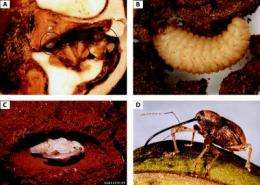Pecan weevil biology, management and control strategies

The pecan weevil, Curculio caryae (Horn), is a major pest of pecans throughout the southeastern United States, as well as portions of Texas and Oklahoma.
In "Biology and Management of the Pecan Weevil (Coleoptera: Curculionidae)," (http://bit.ly/xrqS3d) a new article appearing in the Journal of Integrated Pest Management, scientists from Oklahoma State University and Texas A&M University describe the biology, life stages, crop injury, monitoring approaches, and primary control strategies currently used for pecan weevil in pecan.
Aimed at pecan growers extension personnel using integrated pest management (IPM) strategies, the authors describe monitoring techniques using limb Jarring, tree bands, knockdown sprays, pyramid traps, circle traps, and infestation records.
Other management considerations, such as biological control and livsestock grazing are also discussed.
Finally, suggested economic thresholds are extrapolated from several sources and the utility of current monitoring information is presented to aid in management and quarantine decisions.
Provided by Entomological Society of America



















